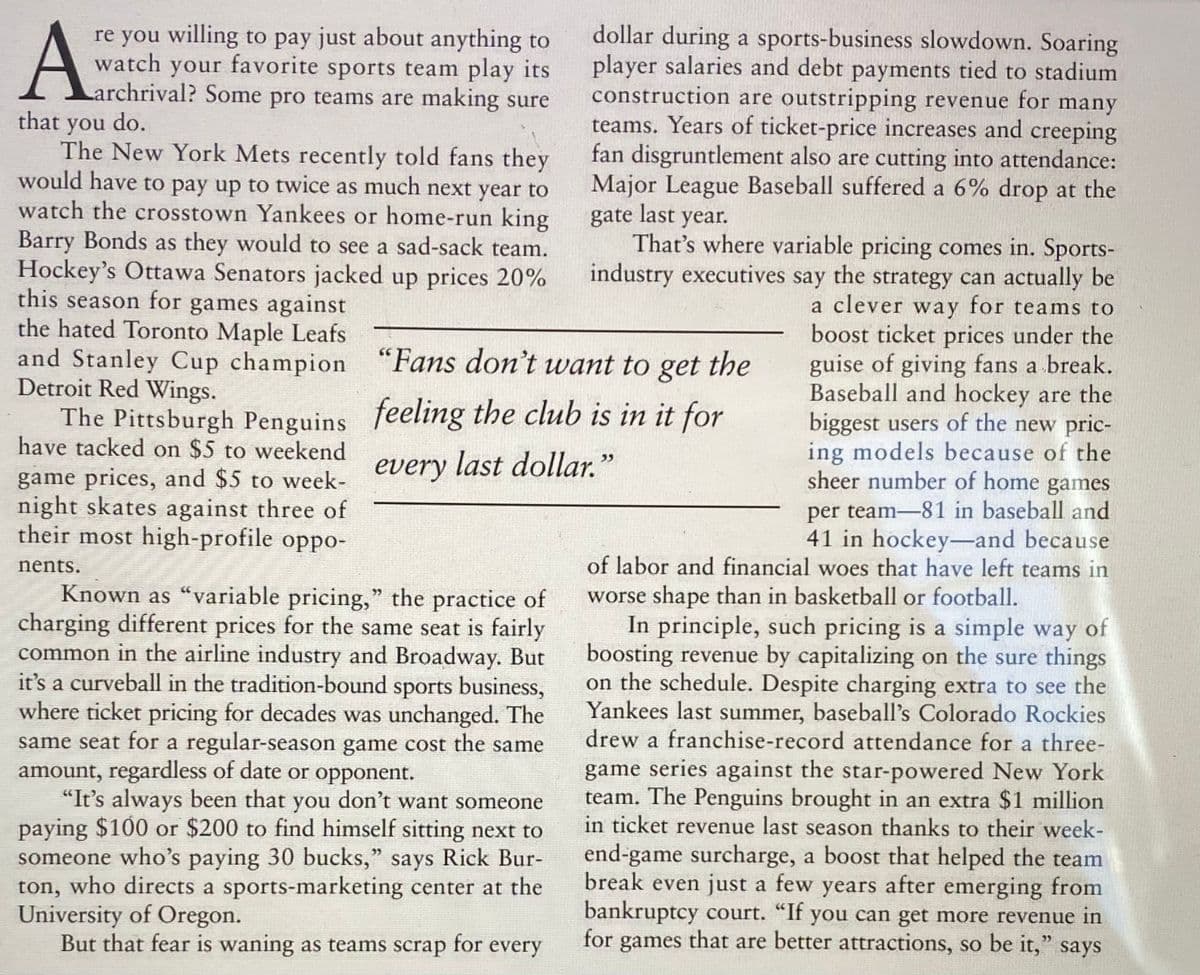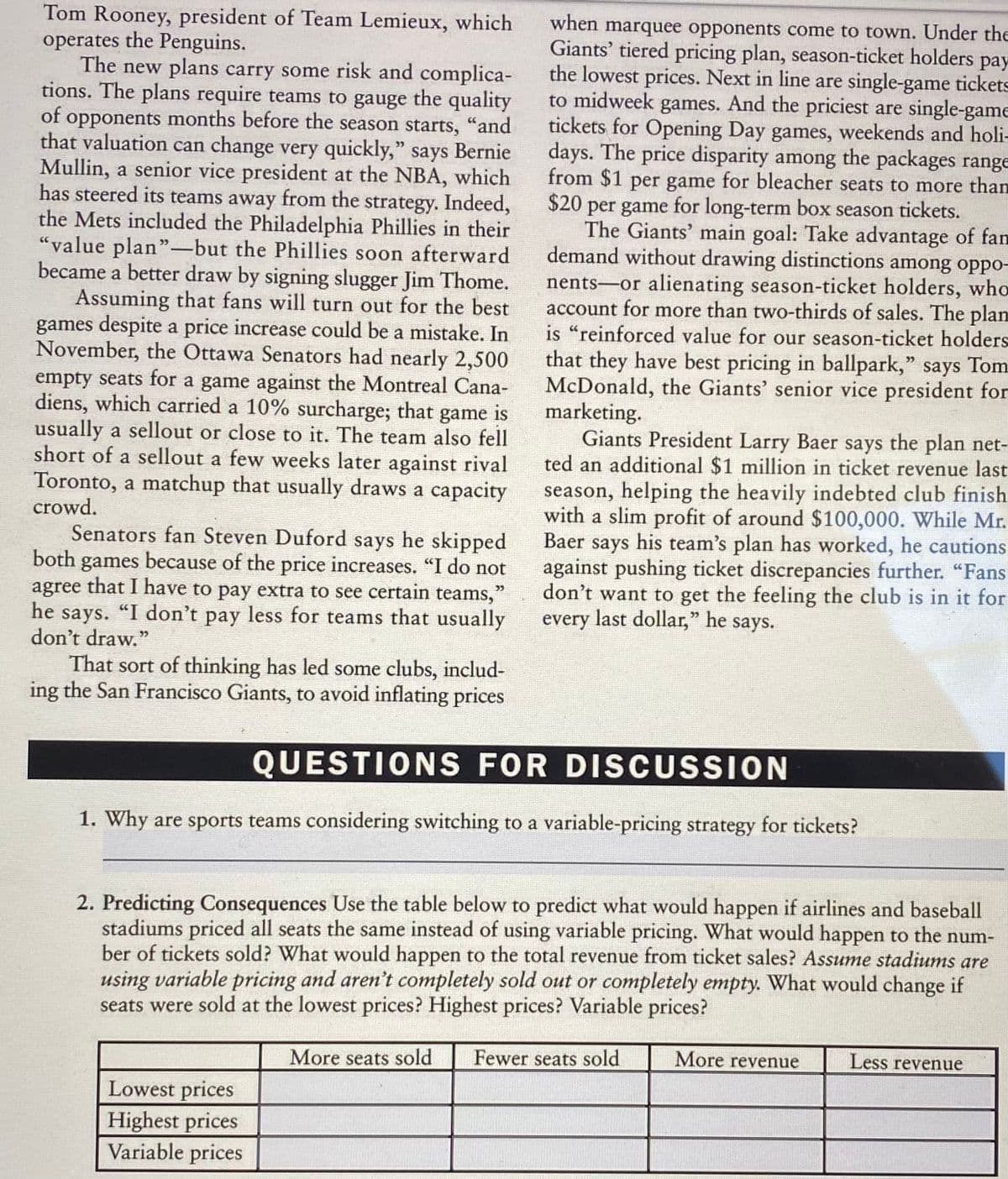Managerial Economics: Applications, Strategies and Tactics (MindTap Course List)
14th Edition
ISBN:9781305506381
Author:James R. McGuigan, R. Charles Moyer, Frederick H.deB. Harris
Publisher:James R. McGuigan, R. Charles Moyer, Frederick H.deB. Harris
Chapter3: Demand Analysis
Section: Chapter Questions
Problem 4E
Related questions
Question
I need help with question 2

Transcribed Image Text:A
dollar during a sports-business slowdown. Soaring
player salaries and debt payments tied to stadium
construction are outstripping revenue for many
teams. Years of ticket-price increases and creeping
fan disgruntlement also are cutting into attendance:
Major League Baseball suffered a 6% drop at the
re you willing to pay just about anything to
watch your favorite sports team play its
Larchrival? Some pro teams are making sure
that you do.
The New York Mets recently told fans they
would have to pay up to twice as much next year to
watch the crosstown Yankees or home-run king
Barry Bonds as they would to see a sad-sack team.
Hockey's Ottawa Senators jacked up prices 20%
this season for games against
the hated Toronto Maple Leafs
and Stanley Cup champion “Fans don't want to get the
Detroit Red Wings.
gate last year.
That's where variable pricing comes in. Sports-
industry executives say the strategy can actually be
a clever way for teams to
boost ticket prices under the
guise of giving fans a break.
Baseball and hockey are the
biggest users of the new pric-
ing models because of the
sheer number of home games
The Pittsburgh Penguins feeling the club is in it for
have tacked on $5 to weekend
game prices, and $5 to week- every last dollar."
night skates against three of
their most high-profile oppo-
per team-81 in baseball and
41 in hockey-and because
of labor and financial woes that have left teams in
nents.
Known as “variable pricing," the practice of
charging different prices for the same seat is fairly
common in the airline industry and Broadway. But
it's a curveball in the tradition-bound sports business,
where ticket pricing for decades was unchanged. The
same seat for a regular-season game cost the same
amount, regardless of date or opponent.
"It's always been that
paying $100 or $200 to find himself sitting next to
someone who's paying 30 bucks," says Rick Bur-
ton, who directs a sports-marketing center at the
University of Oregon.
But that fear is waning as teams scrap for every
worse shape than in basketball or football.
In principle, such pricing is a simple way of
boosting revenue by capitalizing on the sure things
on the schedule. Despite charging extra to see the
Yankees last summer, baseball's Colorado Rockies
drew a franchise-record attendance for a three-
game series against the star-powered New York
team. The Penguins brought in an extra $1 million
in ticket revenue last season thanks to their week-
end-game surcharge, a boost that helped the team
break even just a few years after emerging from
bankruptcy court. "If you can get more revenue in
for games that
you
don't want someone
are better attractions, so be it," says

Transcribed Image Text:Tom Rooney, president of Team Lemieux, which
operates the Penguins.
The new plans carry some risk and complica-
tions. The plans require teams to gauge the quality
opponents months before the season starts, "and
that valuation can change very quickly," says Bernie
Mullin, a senior vice president at the NBA, which
has steered its teams away from the strategy. Indeed,
the Mets included the Philadelphia Phillies in their
“value plan"-but the Phillies soon afterward
became a better draw by signing slugger Jim Thome.
Assuming that fans will turn out for the best
games despite a price increase could be a mistake. In
November, the Ottawa Senators had nearly 2,500
empty seats for a game against the Montreal Cana-
diens, which carried a 10% surcharge; that game is
usually a sellout or close to it. The team also fell
short of a sellout a few weeks later against rival
Toronto, a matchup that usually draws a capacity
when marquee opponents come to town. Under the
Giants' tiered pricing plan, season-ticket holders pay
the lowest prices. Next in line are single-game tickets
to midweek games. And the priciest are single-game
tickets for Opening Day games, weekends and holi-
days. The price disparity among the packages range
from $1 per game for bleacher seats to more than
$20 per game for long-term box season tickets.
The Giants' main goal: Take advantage of fam
demand without drawing distinctions among oppo-
nents-or alienating season-ticket holders, who
account for more than two-thirds of sales. The plan
is "reinforced value for our season-ticket holders
of
that they have best pricing in ballpark," says Tom
McDonald, the Giants' senior vice president for
marketing.
Giants President Larry Baer says the plan net-
ted an additional $1 million in ticket revenue last
season, helping the heavily indebted club finish
with a slim profit of around $100,000. While Mr.
Baer says his team's plan has worked, he cautions
against pushing ticket discrepancies further. "Fans
don't want to get the feeling the club is in it for
every last dollar," he says.
crowd.
Senators fan Steven Duford says he skipped
both games because of the price increases. "“I do not
agree that I have to pay extra to see certain teams,"
he says. "I don't pay less for teams that usually
don't draw."
That sort of thinking has led some clubs, includ-
ing the San Francisco Giants, to avoid inflating prices
QUESTIONS FOR DISCUSSION
1. Why are sports teams considering switching to a variable-pricing strategy for tickets?
2. Predicting Consequences Use the table below to predict what would happen if airlines and baseball
stadiums priced all seats the same instead of using variable pricing. What would happen to the num-
ber of tickets sold? What would happen to the total revenue from ticket sales? Assume stadiums are
using variable pricing and aren't completely sold out or completely empty. What would change if
seats were sold at the lowest prices? Highest prices? Variable prices?
More seats sold
Fewer seats sold
More revenue
Less revenue
Lowest prices
Highest prices
Variable prices
Expert Solution
This question has been solved!
Explore an expertly crafted, step-by-step solution for a thorough understanding of key concepts.
Step by step
Solved in 3 steps with 2 images

Knowledge Booster
Learn more about
Need a deep-dive on the concept behind this application? Look no further. Learn more about this topic, economics and related others by exploring similar questions and additional content below.Recommended textbooks for you

Managerial Economics: Applications, Strategies an…
Economics
ISBN:
9781305506381
Author:
James R. McGuigan, R. Charles Moyer, Frederick H.deB. Harris
Publisher:
Cengage Learning

Principles of Economics 2e
Economics
ISBN:
9781947172364
Author:
Steven A. Greenlaw; David Shapiro
Publisher:
OpenStax

Managerial Economics: Applications, Strategies an…
Economics
ISBN:
9781305506381
Author:
James R. McGuigan, R. Charles Moyer, Frederick H.deB. Harris
Publisher:
Cengage Learning

Principles of Economics 2e
Economics
ISBN:
9781947172364
Author:
Steven A. Greenlaw; David Shapiro
Publisher:
OpenStax